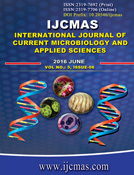


 National Academy of Agricultural Sciences (NAAS)
National Academy of Agricultural Sciences (NAAS)

|
PRINT ISSN : 2319-7692
Online ISSN : 2319-7706 Issues : 12 per year Publisher : Excellent Publishers Email : editorijcmas@gmail.com / submit@ijcmas.com Editor-in-chief: Dr.M.Prakash Index Copernicus ICV 2018: 95.39 NAAS RATING 2020: 5.38 |
Ethno-botanical survey of the plant based folk practices used for treatment of diabetes mellitus was carried out in Tabuk region, Saudi Arabia. The people in the study area still use plant therapy to considerable extent although the modern medical facilities are available. This may be attributed to the availability of plant species specially the cultivated one, the lower cost factor, and to a popular belief that plant derived medicines are better for health care. From the survey, a total of 20 plant species belonging to 14 families are used for treatment of diabetes mellitus in the study area. The most prominent families are Alliaceae, Asteraceae, Fabaceae, Lamiaceae, Lauraceae and Zingiberaceae having two species each. Leaves, seeds, fruits and rhizomes are the commonest parts of plants used, while decoctions and infusions are the main methods of preparations. Trigonella foenum-graecum, Cinnamomum burmannii, Curcuma longa, Olea europaea, Zingiber officinale, Opuntia ficus-indica, Allium cepa and Laurus nobilis are the most commonly used plant species for treatment of diabetes mellitus in Tabuk region. From the review majority, the antidiabetic activity of the common medicinal plants in the study area is attributed to the presence of novel non-protein amino acids (4-Hydroxyisoleucine), polyphenol, phenolic compounds and essential oils which show reduction in blood glucose levels.
 |
 |
 |
 |
 |